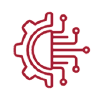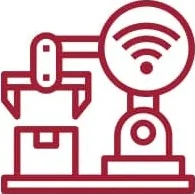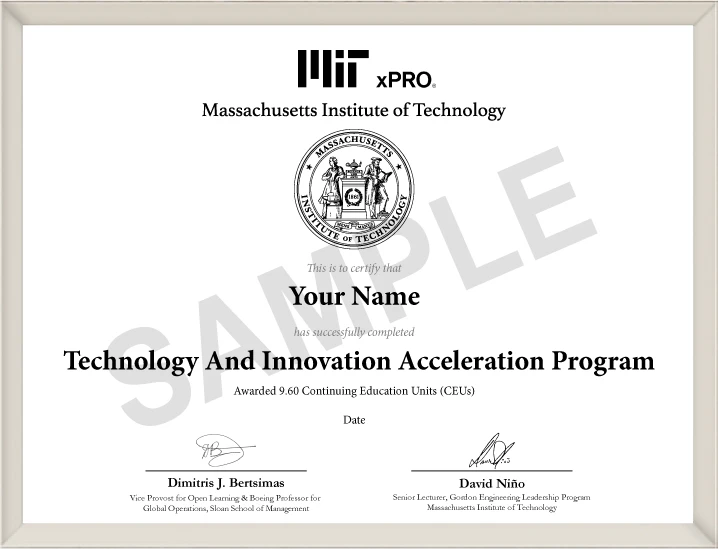Technology and Innovation Acceleration Program
Manage people and technology with excellence
Pay Nothing While You Learn. Financing Options Starting At US$25/Month. Learn more
Leading Into the Next Frontier
Just as technology and business have joined forces to co-create value, technology and leadership have conspired to require a new kind of leader. The skills required of leaders to achieve breakout performance have shifted—dramatically. Now is the time to step out of your comfort zone and prepare for the next frontier.
In order to support technology professionals on this journey, more than 15 MIT faculty have distilled their expertise on key technology accelerators, along with principles of organizational strategy and leadership, into the six-month Technology and Innovation Acceleration Program online.
Being a future-ready leader is about managing both technology and people with excellence. That’s the MIT way.
Organizing Principle: The Six Pillars of Technology Management
Pillar 1: Critical thinking
Analyze the evidence, consider alternate solutions, solve complex problems
Pillar 2: System thinking
Understand how the components of a system interact with each other, identify interdependencies, solve more problems
Pillar 3: Creating value through emerging technologies
Evaluate what technologies can solve your problems and pay off
Pillar 4: Radical innovation
Establish the ground rules for exponential growth
Pillar 5: Organizational strategy
Identify how technology impacts your organizational structure and strategy
Pillar 6: Leadership
Mobilize the people and resources needed to achieve breakthrough performance
Who Is This Program For?
Every industry is prone to disruption. This program is ideal for individuals who are seeking to be on the leading edge of technology innovation while also applying organizational strategies to bolster success. Representative roles include:
Mid- to senior-level managers preparing for technology leadership roles
Functional department heads and business leaders looking to drive tech innovation and strategy across their organization
Senior technology leaders seeking to lead technology innovation, build high-performing teams, and develop strategies for achieving organizational alignment
Consultants seeking to explore emerging technologies, such as AI and AR/VR tools for enabling innovation, and business applications in order to offer cutting-edge solutions for clients
Key Takeaways
Implementing system thinking and architecture to analyze complex systems or processes, create new models, and utilize strategic decision-making
Exploring emerging technologies and their business applications, including artificial intelligence, augmented reality, virtual reality, and quantum computing
Identifying core features and strategies to execute various forms of radical innovation
Aligning organizational strategy to products and teams
Creating and reinforcing a culture of innovation within the organization through advanced leadership strategies
Program Modules
Over the course of six months, you will examine the range of capabilities, from critical thinking to emerging technology to managing technology and innovation, to help you lead with excellence.
Program Highlights

Discussion Boards

Individualized feedback on assignments

Weekly live office hours with Q&A (learning facilitator led)

Access to cutting-edge technologies and concepts from MIT

Application of learning through a final capstone project

Earn a certificate and 10 Continuing Education Units (CEUs) from MIT xPRO
Capstone Project
The capstone project uses the six pillars as the cornerstone of an authentic technology management project aligned to your current or aspirational technology leader role. The final capstone applies learning from each pillar to solve a challenge with practical applications. You will be able to design a project that can be integrated into your real-world setting.
Case Studies

JumpToPC
For many in developing countries, personal computers are out of reach. MIT D-Lab is collaborating with partners to develop a platform that uses a household’s existing smartphone or television to offer at-home computing solutions. Examine the strategic decisions made along the development journey.

Toyota
Were sticky pedals and floor mats to blame for the "unintended acceleration" issues on many Toyota vehicles, or was it a problem with the sensors or software? Peer into the investigation and explore how critical thinking and decision-making were used and abused.

The Robot Compiler
Take a system-thinking tour of how making a custom robot is made possible by compiling parts from a database. Examine each of the computation-driven steps in the process of fabricating a robot—so easy, anyone can have a personal robot.

The Apollo Mission
With countless decisions to be made and competing priorities, how does a team organize a mission to the moon? Examine the decision-making process that the Apollo team used, distinguishing between the architectural decisions that needed to be made first and those decisions that could be made downstream.
MIT Instructors

Seley Distinguished Professor of Management, Professor of Organization Studies, and Founder of the MIT Leadership Center at the MIT Sloan School of Management
Ancona's pioneering research into how successful teams operate has highlighted the critical importance of managing outside, as well as inside, the team's boundary. Ancona's wo...

Professor and Associate Department Head of Aeronautics and Astronautics at the Massachusetts Institute of Technology
Balakrishnan's current research interests are in the design, analysis, and implementation of control and optimization algorithms for large-scale cyber-physical infrastructures...

Clarence J. LeBel Professor in Electrical Engineering and Computer Science at the Massachusetts Institute of Technology
Boning's research is focused on the modeling and control of variation in manufacturing, including IC, photonics, and MEMS processes, devices, and circuits. His research intere...

Director of the System Architecture Lab at the Massachusetts Institute of Technology
Cameron's research interests include technology strategy, system architecture, and the management of product platforms. He has supervised over 50 graduate students and has dir...

Professor of Aeronautics and Astronautics and Ford Professor of Engineering at the Massachusetts Institute of Technology
Crawley's research focuses on the design of complex systems, and he is the author of this text: System Architecture. He is a fellow of the AIAA, and a member of the NAE, as we...

Professor of Aeronautics and Astronautics and Engineering Systems at the Massachusetts Institute of Technology
De Weck's research focuses on how complex man-made systems such as aircraft, spacecraft, automobiles, printers, and critical infrastructures are designed and how they evolve o...

General Motors LGO Professor of Management; Professor of Management Science and Innovation; Co-Director, SDM and IDM Programs at the Massachusetts Institute of Technology
Dr. Eppinger is one of the most highly recognized scholars in the area of product development and technical project management. His research is applied to improving complex de...

MIT D-Lab Faculty Director for Research, Professor of Mechanical Engineering at the Massachusetts Institute of Technology
Frey is actively involved in design of engineering devices for the developing world, and has worked intensively with colleagues, administrators, and the Singapore Ministry of ...

Professor of Digital Media & Artificial Intelligence and Director of the MIT Center for Advanced Virtuality
Harrell's research explores the relationship between imagination and computation, and it involves developing new forms of virtual reality, computational narrative, video gamin...

Managing Director of MIT Machine Intelligence for Manufacturing and Operations
Lawler is a technology entrepreneur and executive leader with consecutive public and private exits, and early-stage investing success with leading venture firms including Acce...

Senior Lecturer, Gordon Engineering Leadership Program at the Massachusetts Institute of Technology
Niño heads leadership education for graduate students across the institute. He is strongly committed to the development of leadership among engineers and other professionals i...

Professor of the Practice of Physics, Associate Director of the Research Laboratory of Electronics (RLE), and Laboratory Fellow at MIT Lincoln Laboratory
In these roles, Oliver provides programmatic and technical leadership targeting the development of quantum and classical high-performance computing technologies. His research ...

Alfred P. Sloan Professor of Management, Professor of Work and Organization Studies, and Associate Dean for Diversity, Equity, and Inclusion at MIT Sloan School of Management
Reagans studies the origin and influence of social capital on knowledge transfer, learning rates, and overall team performance. More specifically, he examines how demographic ...

Research Scientist, Systems Engineering Advancement Research Initiative, Engineering Systems Division at the Massachusetts Institute of Technology
Ross has research interests and advises students in ongoing research projects in advanced systems design and selection methods, tradespace exploration, managing unarticulated ...

Professor of Electrical Engineering and Computer Science, and Director of CSAIL at the Massachusetts Institute of Technology
Rus' work is focused on developing the science and engineering of autonomy, toward the long-term objective of enabling a future with machines pervasively integrated into the f...

Director of Auto-ID Laboratory at the Massachusetts Institute of Technology and Accenture Convergence Initiative for Industry and Technology
Subirana's research centers on IoT and AI, and focuses on manufacturing, e-learning, the creative industries, and digital health. He is developing a voice name system that can...

Vice President for Open Learning and Professor of Mechanical Engineering at the Massachusetts Institute of Technology
Sarma is co-founder of the Auto-ID Center at MIT and developed many of the key technologies behind the EPC suite of RFID standards now used worldwide. He was the founder and C...
Pay Nothing While You Learn. Financing Options Starting At US$25/Month
We offer several options to help you afford tuition for the Technology and Innovation Acceleration Program.
Referrals – You and a colleague can each receive $950 off your tuition when you enroll together. Refer now
Group enrollments – A discount of up to 20% is available for group enrollments. For more information, email group-enrollments@emeritus.org
US Residents (Deferred payment option available)
Sallie Mae – Monthly payments starting at US$25. Click here to apply
*At the time of loan application, please select ‘Undergraduate students’ when prompted.
Rest of the World
Flexible Payment Options – Monthly payments as low as US$1,355. Click here to learn more

Program Certificate
Get recognized! Upon successful completion of this program, MIT xPRO grants a certificate of completion to participants and 9.60 Continuing Education Units (CEUs). This program is graded as a pass or fail; participants must receive 75% to pass and obtain the certificate of completion.
After successful completion of the program, your verified digital certificate will be emailed to you, at no additional cost, in the name you used when registering for the program. All certificate images are for illustrative purposes only and may be subject to change at the discretion of MIT.
FAQs
Didn't find what you were looking for? Write to us at learner.success@emeritus.org or Schedule a call with one of our Academic Advisors or call us at +1 401 443 9591 (US) / + 44 189 236 2347 (UK) / +65 3129 7174 (SG)
Early Registrations Are Encouraged. Seats Fill Up Quickly!
Flexible payment options available.
Starts On
